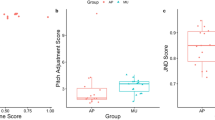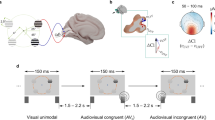People blinded in infancy have sharper listening skills than those who lost their sight later.
Abstract
Do blind people develop superior abilities in auditory perception to compensate for their lack of vision? They are known to be better than sighted people at orientating themselves by sound, but it is not clear whether this enhanced awareness extends to other auditory domains, such as listening to music or to voices. Here we show that blind people are better than sighted controls at judging the direction of pitch change between sounds, even when the speed of change is ten times faster than that perceived by the controls — but only if they became blind at an early age. The younger the onset of blindness, the better is the performance, which is in line with cerebral plasticity being optimal during the early years.
Similar content being viewed by others
Main
Auditory spatial localization is enhanced in early-blind subjects1,2,3, but the effect of blindness on performance in the non-spatial auditory domain is less clear: blind subjects seem to be better at some tasks, such as the perception of chords, than others4,5,6,7. Age at the onset of blindness, which could be an important factor, has not generally been considered.
We compared the performance of a group of early-blind subjects (n = 7; ages, 21–40 years; onset of blindness, 0–2 years after birth), a group of late-blind subjects (n = 7; ages, 24–46; onset of blindness, 5–45 years) and a group of sighted controls (n = 12; ages, 21–37) in judging the direction of pitch change (for details, see supplementary information). In the task, which is based on psychophysical testing of sighted individuals8,9, subjects hear two pure tones of different frequencies at each trial and have to decide whether the pitch is rising (second sound with higher pitch) or falling. In the reference condition (ST in Fig. 1), the pitch difference was one-eighth of an octave (1.5 semitones, or 150 cents) and the duration of each tone was 333 milliseconds (Fig. 1a).
a, Spectrogram of examples of the pure tones used in the task for temporal (T) and spectral (S) series; time increases horizontally and frequency increases vertically; colour intensity reflects the energy of the stimuli. Each tone pair shows a representative example of stimuli used in each of the nine conditions, chosen here with a rising pitch from the first to the second tone. The two tones in each pair were always presented in succession; the impression of temporal overlap for the most rapid conditions (temporal series) is an artefact related to the influence of the acoustic uncertainty principle on the time–frequency representation. b, Proportion of correct answers (±s.e.m.) given by early-blind (blue bars), late-blind (red bars) and sighted (white bars) subjects for the nine conditions. c, Significant negative correlation between age of blindness onset and behavioural performance in the pitch-direction task in temporal (left; T6 to T48) and spectral (right; S16 to S128) conditions. Blue and red dots represent early- and late-blind groups, respectively.
Task difficulty was parametrically manipulated in both the temporal and spectral domains, either by successively dividing tone duration by two (temporal series; T6, 167 ms, up to T48, 20.8 ms) or by dividing the frequency spacing between the tones by two (spectral series; S16, 1/16 of an octave, up to S128, 1/128 of an octave or 4.7 cents). Eight different tone pairs (one rising and one falling, at each of four different frequencies; frequency range, 500–1,000 hertz) were used for each difficulty level. Subjects heard stimuli through headphones binaurally and reported the pitch-change direction by pressing a key.
For all groups, performance was best in the reference condition (ST) and was significantly reduced when either the tone duration (Fig. 1b; ‘T’ bars) or the frequency difference between the tones (Fig. 1b; ‘S’ bars) was decreased (P<0.001). Early-blind subjects showed significantly better overall performance than either the late-blind or sighted subjects (Fig. 1b; main effect, P = 0.008; posthoc Tukey: P = 0.009 and P = 0.026, respectively). The results followed this pattern for both the temporal (P = 0.011) and the spectral (P = 0.011) parts of the data set. Performance by the early-blind group for the most rapid condition (T48) was equivalent to that of sighted subjects in the easiest condition (ST), which comprised durations that were greater by an order of magnitude. No significant difference could be detected between late-blind and sighted subjects (P = 0.67).
There was a significant negative correlation between age of blindness onset and overall performance (partial correlation r = −0.65, P = 0.012) across the entire group of blind subjects; this relation held even after accounting for the duration of blindness (r = −0.49, P = 0.045, one-tailed). Again, this finding held for both the spectral (Fig. 1c, right; r = −0.65, P = 0.011) and the temporal (Fig. 1c, left; r = −0.60, P = 0.024) parts of the data set.
Early-blind subjects were better than both late-blind and sighted subjects at determining the direction of pitch change, for different temporal as well as spectral levels. We conclude that compensatory auditory mechanisms following visual deprivation must extend beyond the spatial domain. Our finding that a large part of the variance (42%) could be accounted for by the age of blindness onset may explain why conflicting results are found when early- and late-blind subjects are pooled together4,6. Moreover, it is in agreement with the idea that cerebral plasticity is more efficient at early developmental stages.
References
Röder, B. et al. Nature 400, 162–166 (1999).
Lessard, N., Paré, M., Lassonde, M. & Lepore, F. Nature 395, 278–280 (1998).
Muchnick, C., Efrati, M., Nemeth, E., Malin, M. & Hildesheimer, M. Scand. Audiol. 20, 19–23 (1991).
Sakurabayshi, H., Sato, Y. & Ueehara, E. J. Psychol. Blind 1, 3–10 (1956).
Pitman, D. J. Am. Found. Blind. Res. Bull. 11, 63–79 (1965).
Juurma, J. Am. Found. Blind. Res. Bull. 14, 109–122 (1967).
Stankov, L. & Spilsbury, G. Appl. Psychol. Meas. 2, 491–503 (1978).
Johnsrude, I. S., Penhune, V. B. & Zatorre R. J., Brain 123, 155–163 (2000).
Zatorre, R. J. & Belin, P. Cereb. Cortex 11, 946–953 (2001).
Author information
Authors and Affiliations
Corresponding author
Ethics declarations
Competing interests
The authors declare no competing financial interests.
Rights and permissions
About this article
Cite this article
Gougoux, F., Lepore, F., Lassonde, M. et al. Pitch discrimination in the early blind. Nature 430, 309 (2004). https://doi.org/10.1038/430309a
Published:
Issue Date:
DOI: https://doi.org/10.1038/430309a
This article is cited by
-
Partial visual loss disrupts the relationship between judged room size and sound source distance
Experimental Brain Research (2022)
-
Acquired olfactory loss alters functional connectivity and morphology
Scientific Reports (2021)
-
Do blind people share the tall-man stereotype?
Current Psychology (2021)
-
Development of Auditory Cortex Circuits
Journal of the Association for Research in Otolaryngology (2021)
-
Blind footballers direct their head towards an approaching ball during ball trapping
Scientific Reports (2020)
Comments
By submitting a comment you agree to abide by our Terms and Community Guidelines. If you find something abusive or that does not comply with our terms or guidelines please flag it as inappropriate.




